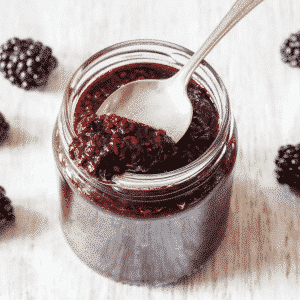While a peanut butter (or nut-free alternative) and jelly sandwich has been the go-to option for a no-fuss meal forever, how do you know if you’re picking out the best jam or jelly for your baby? There are so many options in the jelly aisle that it can be overwhelming. Should you be looking for lower sugar or higher fiber? What’s most important?
This post may contain affiliate links and when you click on the links I may earn a small commission at no charge to you. As an Amazon affiliate, I earn a commission from qualifying purchases.
Can babies have jam?
The American Academy of Pediatrics recommends no added sugars before age 2 which would make using any store bought jam very difficult. You can make your own no-sugar added alternative to offer to your baby or opt to hold off until your baby gets a little bit older to offer jam.
What’s the difference between jelly, jam, preserves, and spreads?
All of these are made with some form of fruit mixed with sugar and pectin. Pectin is what gives jams and jellies their consistency. Jelly is made from fruit juice. It is generally the easiest to spread. Jams will be made from mashed fruit. Preserves will have large pieces of fruit or whole fruit. Marmalades are a subcategory of preserves made from citrus fruit. Fruit spreads should be 100% fruit with no additional sugar added. Sometimes juice will be added to spreads as a sweetener. The FDA has not defined “fruit spread”, so there is varied interpretation. Due to the fact that they are made from fruit, any of these spreads will contain some sugar.
Store-bought versus homemade
This will really come down to how often you use it and how important it is to you to keep added sugars to a minimum. You can look for a fruit spread that is truly just 100% fruit, but that may be difficult to find.
If it’s something that you are not using often, you can spread just a thin layer for a taste. If your child is younger than 2, you may want to consider making it yourself so that you can opt for a no-added sugar version. (Check out my Starting Solids Made Easy Course for more information on feeding your baby.) Remember that with responsive feeding, you are in charge of what foods your child is offered, so if it is important to you to limit added sugars, you may want to opt to make your own. As an alternative to jam, you can also try this no-sugar added cranberry sauce. It’s a hit every fall.
What is the best jam for your toddler or baby?
If you are opting for store-bought jam, here are a few things that you can look for:
- fruit should be the first ingredient
- low in added sugars
- avoid artificial sweeteners in place of sugar
Store Bought Examples
Why chia jam?
Chia seeds bind with water to help make that jammy consistency without having to use pectin. They are a good source of iron and because you are adding in fruit, you’re adding in vitamin C. This power combo is perfect for little ones. Babies can have chia seeds. Unlike bigger seeds, they are not considered a choking hazard. You can mix up which fruit you use (like this pomegranate version) to give your baby a variety of different flavors that may not be easily available in the store.
Easy Homemade Chia Jam
Ingredients
- 2 cup frozen fruit
- 1 tbsp water
- 1 tbsp lemon juice
- 2 tbsp chia seeds
- 1 tbsp maple syrup or honey (optional: omit for babies)
Instructions
- Add fruit, water, and lemon juice to a medium saucepan. Bring to a boil.
- Turn down the heat and let simmer 5-7 minutes. You want the fruit to be mostly broken down.
- Use an immersion blender, potato masher, or fork to break up any fruit chunks.
- Stir in chia seeds and sweetener (if using). Let sit ~10 minutes until the chia has absorbed most of the liquid.
- Transfer to a mason jar or storage container and store in the fridge.
Nutrition

Krystyn Parks is a Registered Dietitian and Lactation Consultant who specializes in feeding children. She has a Master’s Degree in Nutritional Science from California State University Long Beach. She is an International Board Certified Lactation Consultant and has been registered with the Commission on Dietetic Registration since 2013.

